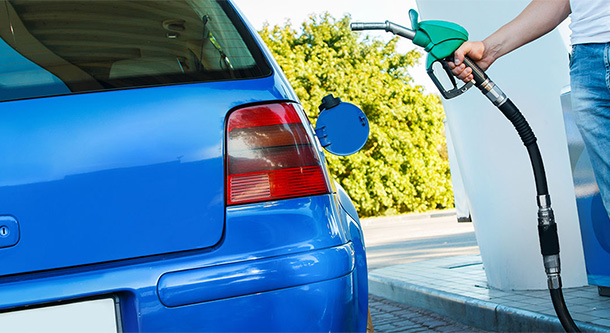
The national gas price average has held relatively flat for the last two weeks. Today’s national average is $2.86. The Energy Information Administration’s (EIA) latest reports detail a drop in consumer gasoline demand and a build in gasoline inventories. In fact, this was the first increase in inventories in six-weeks with a substantial addition of 3 million bbl.
“With a flat national average, U.S. gasoline supply and demand suggest they are balancing,” said Jeanette Casselano, AAA spokesperson. “But that’s not to say that we could not see spikes in demand closer to Labor Day as motorists squeeze in those final road trips.”
On the week, states are seeing pump price jumps as high as eight cents and drops as much as a dime. Today’s gas price average is one-cent less than last week, three-cents less than one month ago and 51-cents more than this time last year.

Quick Stats
- The nation’s top 10 most expensive markets are: Hawaii($3.76), California ($3.61), Washington ($3.39), Alaska ($3.36), Oregon ($3.27), Idaho ($3.22), Nevada ($3.19), Utah ($3.12), Connecticut ($3.06) and Pennsylvania ($3.06).
- The nation’s top 10 largest weekly changes are: Ohio (-10 cents), Indiana (-8 cents), Michigan (+7 cents), Idaho (+7 cents), Florida (+6 cents), Utah (+4 cents), New Mexico (+4 cents), Missouri (-3 cents), Delaware (-3 cents) and South Carolina (-3 cents).

West Coast
Pump prices in states in the West Coast region are among the highest in the country: Hawaii ($3.76), California ($3.61), Washington ($3.39), Alaska ($3.36), Oregon ($3.27), Nevada ($3.19) and Arizona ($2.89). When compared to last week, all pump prices in the region are down. Arizona (-2 cents) saw the largest drop.
According to EIA’s petroleum status report for the week ending on August 3, inventories of gasoline in the region grew by 200,000 bbl. They now sit at 30.4 million bbl, which is nearly four million bbl higher than total levels at this time last year. Growing supplies will provide a cushion for price fluctuations, which could help pump prices stabilize if there are any shocks to regional supply this week.

Great Lakes and Central
On the week, gas prices across the Great Lakes and Central states are seeing declines or stabilization. Michigan (+7 cents) and Illinois (+1 cent) were the only states to see an increase in the region. Ohio (-10 cents), Indiana (-8 cents) and Missouri (-3 cents) have the largest weekly decrease in pump prices in the country and the region.
The majority of states across the country are paying less to fill-up at the pump compared to last month with four Great Lakes and Central states landing on the top five list: Ohio (-18 cents), Indiana (-15 cents), Kentucky (-10 cents) and Missouri (-7 cents).
With a substantial 1.7 million bbl build, gasoline inventories are above the 53 million bbl mark for the first time in a month. In fact, this was the first build for the region since the end of June and contributed to this week’s cheaper or stable prices across the Great Lakes and Central states.
South and Southeast
The majority of states in the South and Southeast saw gas prices drop between one and two cents on the week. However, some states saw prices increase close to a nickel or more: Florida (+6 cents), New Mexico (+4 cents), and Louisiana (+2 cents).
Of the top 10 cheapest state gas price averages this week, seven are in the South and Southeast region: Mississippi ($2.56), South Carolina ($2.57), Alabama ($2.57), Arkansas ($2.59), Texas ($2.62), Louisiana ($2.62) and Oklahoma ($2.62)
The EIA reports regional inventory increased by 1.3 million bbl, lifting regional levels back above 79 million bbl total and pushing the majority of gas price state averages down. Despite the increase, total levels are at a 2.1 million bbl deficit compared to this time last year.
Mid-Atlantic and Northeast
Gas prices are mostly flat across the Mid-Atlantic and Northeast region with eight states seeing two to one cent pump price drops while seven states’ gas price averages held flat on the week. Delaware (-3 cent) saw the largest change of any state in the region.
Four states in the region currently carry gas prices above the $3 mark: Connecticut ($3.06), Pennsylvania ($3.06), Washington, D.C. ($3.03) and New York ($3.01).
Pump prices and inventories remained relatively flat at 64 million bbl on the week, according to the latest EIA data available. Total inventory levels are on par with levels this time last year. If they tighten, prices would likely increase.
Rockies
Idaho ($3.22) and Utah ($3.12) are among the top 10 states with the most expensive gas prices in the country. Both of these states saw pump prices jump on the week – seven and four cents respectively, along with Wyoming (+1 cent). Montana’s ($2.94) gas price average dropped a penny while Colorado’s ($2.80) gas price average held flat since last Monday.
However, compared to a year ago, gas prices are much more expensive. Utah (+59 cents), Idaho (+57 cents) and Wyoming (+57 cents) are on the top 10 list for largest year-over-year change in gas prices. Gas prices are nearly 50 cents or more in Montana (+53 cents) and Colorado (+47 cents).
Gasoline inventories took the largest plunge since the end of June with a nearly 300,000 bbl drop. EIA reports that regional inventory levels are at the lowest levels of the year. If they keep pushing down, which is likely as peak tourism season in the region draws to a close, gas prices may increase.
Oil market dynamics
At the close of Friday’s formal trading session on the NYMEX, WTI increased 82 cents to settle at $67.63. Oil prices took a slight step back last week after EIA’s report showed a smaller-than-expected drawdown of crude inventories. Falling approximately 1.35 million bbl, total crude inventories now sit at 407.4 million bbl, which is roughly 68 million bbl lower than where they were this time last year. Lower crude stocks, amid high global crude demand, have helped to increase global crude prices this year over last. However, if total domestic crude inventories continue to disappoint the market this week, oil prices may slide further.
In related news, according to Baker Hughes, Inc., the U.S. added 10 oil rigs last week, bringing the total to 869. Currently, there are 101 more active rigs this year than last year at this time.
Motorists can find current gas prices along their route with the free AAA Mobile app for iPhone, iPad and Android. The app can also be used to map a route, find discounts, book a hotel and access AAA roadside assistance. Learn more at AAA.com/mobile.
